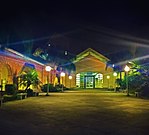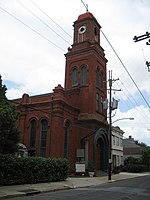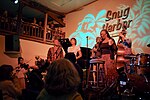Marigny Opera House
19th-century Roman Catholic church buildings in the United StatesFaubourg MarignyFormer Roman Catholic church buildings in the United StatesGerman-American culture in LouisianaMusic venues completed in 2011 ... and 4 more
Opera houses in LouisianaPerforming arts centers in LouisianaRoman Catholic churches completed in 1853Theatres in New Orleans

Marigny Opera House, also known as the Church of the Arts, is an opera house and performing arts center in Faubourg Marigny, New Orleans, Louisiana. The Marigny was originally a Catholic parish church known as Holy Trinity Catholic Church. It was closed by the Archdiocese of New Orleans in 1997. After adaptation and renovation, it was reopened as an opera house in 2011. A resident professional contemporary ballet company, Marigny Opera Ballet, was founded there in 2014. OperaCréole, founded in 2008, also produces works there.
Excerpt from the Wikipedia article Marigny Opera House (License: CC BY-SA 3.0, Authors, Images).Marigny Opera House
Saint Ferdinand Street, New Orleans
Geographical coordinates (GPS) Address Nearby Places Show on map
Geographical coordinates (GPS)
| Latitude | Longitude |
|---|---|
| N 29.96503 ° | E -90.04913 ° |
Address
Saint Ferdinand Street 725
70117 New Orleans
Louisiana, United States
Open on Google Maps






